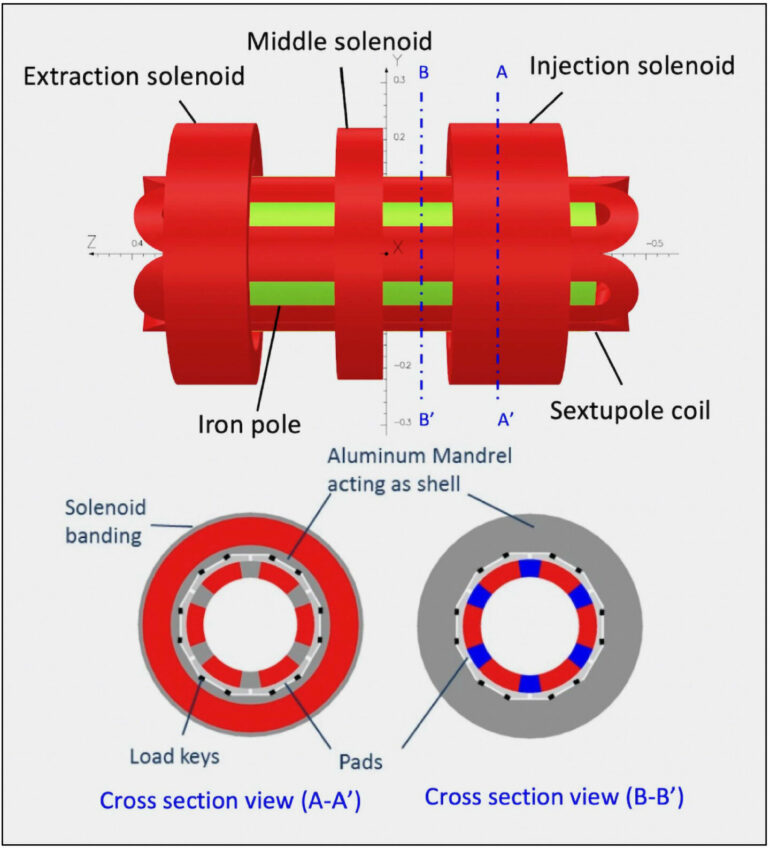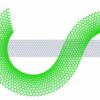Researchers from Berkeley Lab’s Accelerator Technology & Applied Physics (ATAP) Division have teamed up with colleagues from Michigan State University’s Facility for Rare Isotope Beams (FRIB), the world’s most powerful heavy-ion accelerator, to develop a new superconducting magnet based on niobium-tin (Nb3Sn) technology.
This magnet, the first of its kind, could significantly improve FRIB’s performance and enhance its capabilities, opening up new applications in medicine, industry, and research. The paper is published in the journal IEEE Transactions on Applied Superconductivity.
At FRIB, beams of ionized atoms (ions) of elements spanning the periodic table, including heavy elements like uranium, are accelerated to half the speed of light. When these beams collide with a target, they break apart to create short-lived isotopes.
By studying these rare isotopes, some of which have never been observed, scientists can better understand the structure of matter and the formation of our universe.
“A key component of FRIB is an electron cyclotron resonance ion source, or ECRIS, which creates high-current, high-charge state ions for injection into the accelerator beamline,” explains Tengming Shen, a staff scientist in ATAP’s Superconducting Magnet Program (SMP) who is leading the development of the new magnet.
“This ECRIS uses a sextupole magnet and solenoid to confine the electrons and ions in a plasma. The electrons are then heated with high-frequency (28 GHz) microwaves, creating high-energy electrons that strip electrons from neutral atoms in the plasma to produce high charge state ions.” (This configuration, notes Shen, is based on the Versatile ECRIS for Nuclear Science (VENUS) design used in the cyclotron accelerator at Berkeley Lab.)
Fabricated at Berkeley Lab, this sextupole magnet is wound with superconducting niobium-titanium (Nb-Ti) coils. However, 28 GHz Nb-Ti magnets have a peak field of 6.7 tesla (T) at the liquid helium temperatures (4.2 Kelvin, -452.1°Fahrenheit) at which the ECIRS is operated.
Shen says that to improve the facility’s performance and expand its range of applications, the ECRIS needs to be constructed with magnets that can produce higher magnetic fields to enable operation at higher microwave frequencies.
“Our goal is to increase the microwave frequency to over 45 GHz. At this frequency, the peak magnetic field increases to 10.8 T; however, the current-carrying capacity of Nb-Ti material significantly diminishes.”
Toward this end, the researchers chose a magnet design based on superconducting coils made from Nb3Sn. Coils made from Nb3Sn can carry a high current density of more than 100 amperes per square millimeter at much higher magnetic fields—potentially up to 22 T—than those produced by Nb-Ti at 4.2 K.
However, while the superconducting properties of Nb3Sn exceed those of Nb-Ti, Shen says the conductor characteristics of Nb3Sn are very different from those of Nb-Ti.
“For instance, unlike Nb-Ti, Nb3Sn is brittle and sensitive to strain. Additionally, coils made from Nb3Sn undergo dimensional changes during fabrication, which demands greater management of the fabrication process.
“Furthermore, the magnet is constructed using small conductors rather than the large Rutherford cables used in current magnet designs and requires around three hundred turns for each coil.”
He says these factors add to the complexity of producing the coils and assembling a magnet.
“Consequently,” he continues, “fabricating Nb3Sn coils is more challenging, especially for this first-of-its-kind magnet for which no blueprint currently exists. Therefore, creating such a magnet requires extensive experience designing and fabricating superconducting magnets.”
Luckily, Berkeley Lab has considerable experience working with Nb3Sn-based magnets. Last year, for example, the Lab successfully fabricated and assembled the first set of quadrupole magnets made from Nb3Sn superconducting cables.
This work is part of the U.S. Accelerator Upgrade Project’s ongoing contribution to the High Luminosity Large Hadron Collider Accelerator Upgrade Project, which aims to enhance the capabilities of the Large Hadron Collider, promising new discoveries in high-energy and particle physics.
The development of this ECRIS magnet “is an excellent example of how high-field accelerator magnet R&D for future colliders can benefit other science applications,” says Soren Prestemon, Deputy Director of Technology at ATAP and Head of SMP.
“Furthermore, it provides an excellent opportunity for our talented team of scientists, engineers, and technical staff to contribute directly to new and operating facilities like FRIB and the advancement of high-energy physics research.”
Shen says the team has already conducted numerous magnetic and mechanical design calculations to manage Nb3Sn’s stain-sensitive nature.
“We have also evaluated the conductor fabrication process, conducted winding and fabrication trials, and developed a new design that addresses the challenges of coil fabrication. We are close to completing the practice coil, tooling design, fabrication procedures, and processes.”
He adds that work has already started on winding a full-sized prototype coil, and they intend to test a full-length version soon to verify its superconducting performance. If the test proves successful, he says they plan to develop, construct, and test a 28 GHz system with “an eye to future upgrades.”
According to Jie Wei, director of the Accelerator Systems Division at FRIB and the facility’s lead collaborator on the work, the new magnet design based on Nb3Sn technology “will lead to a higher magnetic field than the current Nb-Ti source, offering superior performance while providing a greater safety margin. More importantly, it enables a new ECR source design for operating at higher frequencies (up to 45 GHz) and increased plasma power.”
When completed, he says the magnet “will ensure that FRIB remains at the frontier of fundamental scientific research.”
More information:
Tengming Shen et al, Design and Development of a 28 GHz Nb3Sn ECR Ion Source Superconducting Magnet, IEEE Transactions on Applied Superconductivity (2024). DOI: 10.1109/TASC.2024.3358767
Provided by
Lawrence Berkeley National Laboratory
Citation:
Niobium-tin magnet could be key to unlocking potential of heavy-ion accelerator (2024, October 4)



